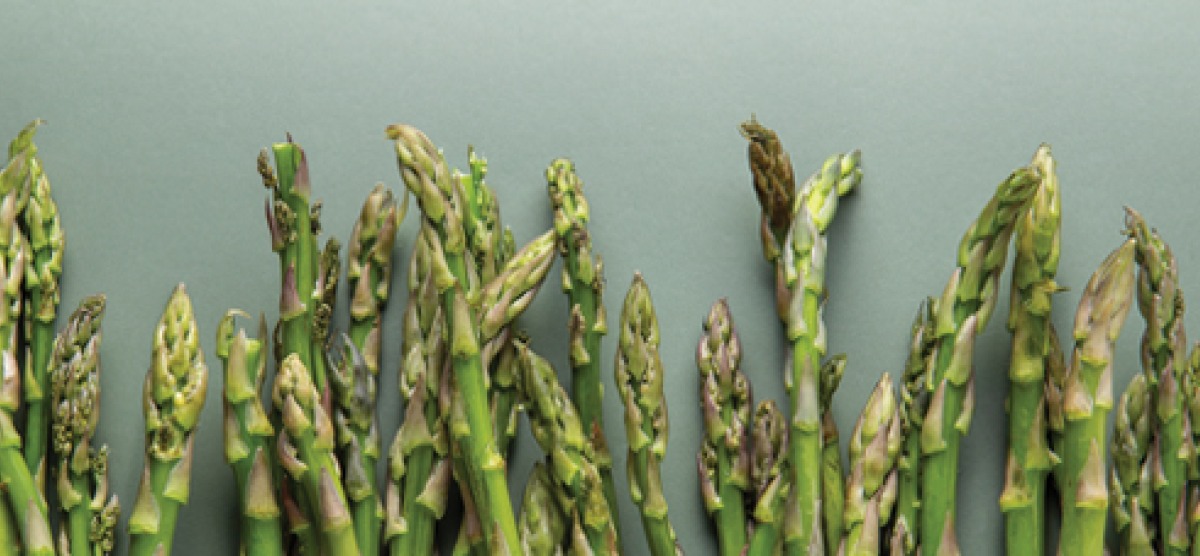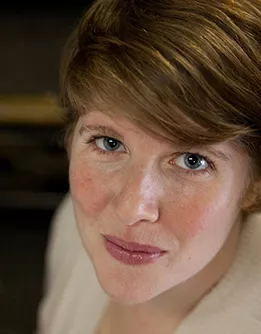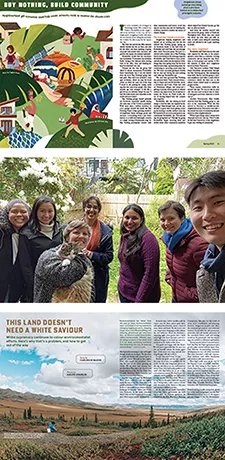
Growing Asparagus
Through her award-winning magazine, Vancouver-based Mawrter Jessie Johnston ’04 tells the large and small stories of sustainability.
Jessie Johnston ’04 had an idea for a magazine that she couldn’t stop thinking about. It percolated in her head for years until she decided that she would rather fail than never try to publish it.
That germ of an idea is now the award-winning Asparagus, a publication dedicated to telling the large and small stories of sustainability. Johnston launched the magazine online in February 2018, with a story about a zero-waste grocery store in Vancouver, British Columbia. And since then, it has grown into eight print issues and hundreds of digital stories.
“It was really important to me to start the magazine and just make one issue,” she said. “And if I got to keep going, great. And if I didn’t, I would’ve at least tried to do the thing that I needed to do.”
“And now, every new issue that we do feels like a gift.”
The Roots
The Asparagus seed was planted decades ago. Johnston was introduced to magazines earlier than most children. Her father “accidentally” launched a publication about AutoCAD after he circulated one newsletter. He thought it would be a one-off deal, until he was bombarded with calls from advertisers who saw an opportunity to publish more material on the fast-growing software application. She grew up surrounded by that homegrown magazine operation and piles of magazines in her home as both of her parents were voracious readers.
She’s always loved the form of magazine storytelling, and it’s long been her dream to be at the editorial helm of a print publication. Even during her Bryn Mawr days, when she was working on The College News and majoring in linguistics, she knew that editorial work was the career path for her.
Similarly, her interest in the environment and sustainability took root when she was young. Johnston grew up in Vancouver, where the urban center is surrounded by mountains, forests, and sea. She was introduced to hiking, camping, and playing outside when she was a kid.
“I felt very connected to the natural world during childhood. And, as an adult, I’m finding more and more that I relate to a concept from Indigenous cultures, that there’s no separation between humans and nature; we’re all united.”
“Children understand that, but we raise them to separate themselves from nature, and then we grow to not respect it as much.”
She was a pint-sized environmentalist, even if the word wasn’t in her vocabulary yet.
Through every stage of her education and career, Johnston never wavered from her magazine aspirations. She landed an internship—and then a job—at National Geographic Traveler, which gave her valuable experience in the industry. But as a Canadian citizen, she confronted hurdles with landing any other job in American print media. And with limited opportunities for upward mobility at National Geographic Traveler, she decided to go home to Vancouver and pivot.
Back in Vancouver, she enrolled in a master’s of publishing program at Simon Fraser University so she could build additional skills in publishing beyond her writing and editorial experience. Once there, she took a job as a project manager at a friend’s web development company, which gave her a quick and intense immersion into managing the daily operations of a business.
When she got laid off from that position a few years later, it pushed her to pursue her own passion project. She suddenly had a surplus of time and the experience she needed to finally launch the magazine she couldn’t stop thinking about.
A Storytelling Ecosystem
Johnston created the magazine she wanted to read—one with a smart, eclectic approach to sustainability stories.
Asparagus covers both the day-to-day aspects of sustainability—like what toilet paper or laundry detergent is best for the environment—and the bigger, systemic issues that
drive climate change and environmental injustice.
That’s how we’re all living our lives right now, she says, with the small daily decisions happening alongside the more complex issues. She wanted to create a storytelling ecosystem that mirrors that reality.
“We want to meet people where they’re at and support them in the day-to-day decisions about how to live more sustainably,” says Johnston. “And we hope that taking away some of the weight of those daily choices will give people space to engage more with the more complex issues.”
If you thumb through the latest issue of Asparagus, you’ll find advice on eco-friendly bedding, a compilation of first-person stories about living through climate disasters, and an article about France’s approach to home energy improvements.
Johnston can point to many ways that Asparagus has influenced her own relationship with sustainability—from the daily decisions to the bigger environmental issues.
“I really, really don’t want to bring any more plastic into my life,” she says. This means she often shops at the same zero-waste grocery store from that first article in 2018, opts for the sushi rice that comes in paper packaging, and squeezes every last ounce of life out of any plastic she already owns.
When it comes to the systemic issues, she feels that Asparagus reinforces how complex every environmental issue really is.
“I keep learning more about how everything is connected; it’s never just an isolated question,” she says, citing the multifaceted problem of large fires in Brazil, which are fueled by a pile of issues, including colonialism, capitalism, and a problematic demand for cheap meat. “The magazine feeds the Bryn Mawr part of me that loves knowing and understanding things,” she says. While some climate issues can feel like an unending spiral of doom, she says climate storytelling is about sharing both the honest reality of challenging issues and the possible solutions.
“We want to tell the stories that give the information we need to understand the world we’re in, and some of those stories are a downer, and we want to tell stories that help
us understand the actions we can take,” she says. “Humans have the capacity to do something about climate change.”
“It’s a really important balance,” says Alia Dharssi, deputy editor of Asparagus. “It can be challenging to talk about climate change because too much negativity can fuel a sense of apathy. Jessie’s vision for Asparagus has always been to do things a little bit differently and publish a magazine that takes the problem of climate change seriously but can also share engaging, fun, and hopeful stories that engage people in a more effective way.”
Interdependence and Connection
Perhaps the most impactful aspect of her work with Asparagus has been learning from Indigenous contributors—who have shared their perspectives and values, shaped by millennia of coexisting with the natural world and natural kin, such as plants, animals, and water.
“The idea of interdependence and connection with the natural world is so powerful,” Johnston says. “The more I can weave those ideas into my life and expose others to those ways of thinking, we’ll all be better for it.”
The contributor roster for Asparagus is as diverse as the content in each issue. Johnston believes it’s critically important to create space for marginalized writers to tell both the stories from their communities and to tell stories, period.
“We need diversity in the industry—not just in telling stories from marginalized communities but in telling all of the stories,” she says. “We want to bring diverse perspectives to every kind of story.”
From the contributors to the content, it’s easy to see the values of Asparagus on every page of the magazine. And, t’s easy to see the values of Asparagus on the page itself. Every issue of Asparagus is printed on 100% post-consumer recycled paper, instead of the virgin fiber you would find between the covers of most magazines.
It’s a decision that comes at a high financial cost, but it’s “non-negotiable,” says Johnston. She explains that recycled paper is more sustainable in every way. You don’t need to cut down more trees to produce recycled paper or put a greater dent in the carbon sink created by forests. And you save lots of energy by using recycled paper as you eliminate everything from cutting down trees, to transporting logs, and turning them into mulch and paper.
The Future of Asparagus
Like many other businesses, Asparagus was hit by the COVID-19 pandemic. Its readership stagnated, and while it’s started growing again in recent months, Johnston
worries that it’s too little, too late.
We are in an era where many print magazines are folding, and it’s hard to cut through the noise on social media to connect with readers. While the challenges are real, Johnston can easily point to many ways that she sees Asparagus as a success, especially considering “Asparagus isn’t even in kindergarten yet.”
The magazine has won three awards and been nominated for many others. It’s educated and empowered readers through eight issues. It’s growing. And perhaps most importantly, it’s never wavered from its mission.
“We created a magazine that’s welcoming to people of all kinds of backgrounds that care about the fate of the natural world and the fate of fellow human beings. We’ve connected our readers with a community that will change them for the better—and empowered them with ideas and knowledge to make the world a better place.”
When she thinks about the uncertain fate of Asparagus, she remembers starting the publication nearly five years ago and just wanting to publish one issue of this magazine that she couldn’t stop thinking about.
Now that she’s well past that one issue, Johnston is at peace with whatever happens, but she certainly hopes Asparagus keeps going.
“I know we can keep doing important things and bringing stories to the world that have value,” she says.
Sustainability at Bryn Mawr College
Bryn Mawr’s ongoing commitment to environmental sustainability encompasses a broad swath
of campus initiatives and projects. The Sustainability Leadership group, made up of students, staff, and faculty, leads campus sustainability efforts.
Offsets
• On Earth Day 2021, the College announced the goal of achieving carbon neutrality by 2035.
• The College’s electricity purchasing agreement includes renewable energy certificates that certify that 100% of the College’s electricity consumption is offset with wind resources entering the grid.
The College has also contracted directly with
a wind generator for the campus’s power supply.
• During Earth Week 2021, the community helped plant 100 trees on campus of four different species. Students will measure their growth and calculate carbon sequestration as part of their course work.
• The College has partnered with the Pennsylvania Environmental Commission to plant up to 400,000 trees on legacy mine lands. Students and faculty visited a site in Altoona in 2022 to plant trees and set up methodology for monitoring carbon.
Reducing Consumption
• The New Student Life and Wellness Building has several sustainability features, including a rain garden, high-efficiency HVAC systems, a well-insulated building envelope, and efficient plumbing and electrical fixtures (including LED lighting).
• The College continues to replace HVAC equipment with more efficient models. A new chiller in the Chemistry wing, for example, will improve the efficiency over the existing boiler by approximately 20 percent by using magnets to reduce friction.
• As part of an ongoing LED lighting conversion, large areas of Park Science and Dolwen recently received upgraded lighting.
• The Dining Hall has launched reusable takeout containers.
• Continuing building envelope improvements include replacement windows in the biology wing.
• Bottle filling stations installed across campus facilitate use of reusable water bottles.
• The College plans to transform more of the campus into no-mow, low-mow areas, such as several wildflower areas.
Storm Water Management
• A raingarden and underground stormwater infiltration basins have been installed at the new Student Life and Wellness Building.
• The College’s storm water management infrastructure includes a pervious plaza at Park Science, an underground infiltration bed under Applebee field, and a stormwater retention
pond (Vickers Lake).
Conversion of the College’s Vehicle Fleet to Electric
• The first electric Blue Bus will arrive on campus this summer. The biology department recently replaced one of its vehicles with a hybrid model, and the College currently has a compressed natural gas bus and three buses that use clean fuel technology including seasonal biodiesel.
• Working with our grounds contractor, the College is converting leaf blowers and trimmers to electric from gas where feasible.
• A solar-powered EV charging station will also be piloted on campus in the coming months.
Published on: 02/20/2023


